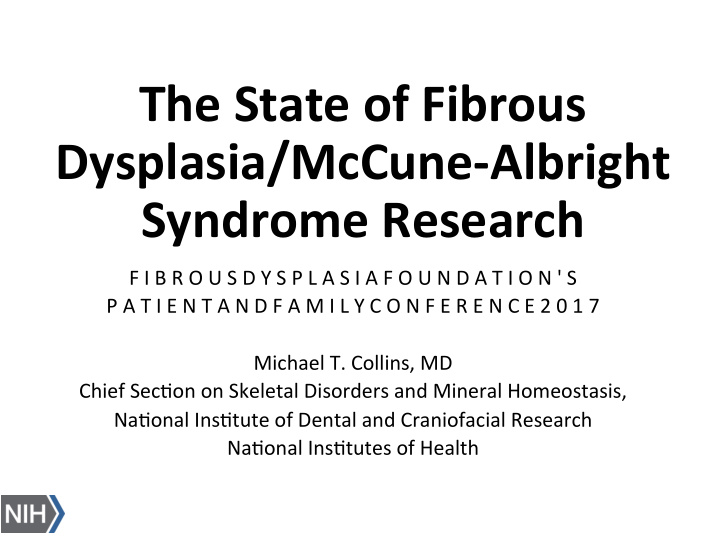



The State of Fibrous Dysplasia/McCune-Albright Syndrome Research F I B R O U S D Y S P L A S I A F O U N D A T I O N ' S P A T I E N T A N D F A M I L Y C O N F E R E N C E 2 0 1 7 Michael T. Collins, MD Chief SecDon on Skeletal Disorders and Mineral Homeostasis, NaDonal InsDtute of Dental and Craniofacial Research NaDonal InsDtutes of Health
Fibrous dysplasia /McCune-Albright Syndrome Skeleton • Craniofacial op?c canal • Axial FD • Appendicular Extra-skeleton • Endocrine - thyroid - precocious puberty • Skin • Others
What causes FD/MAS? ?ssue cells x protein (Gαs) x gene ( GNAS )
What does Gα s do: It is a master regulator of cell ac?vity; an “on and off switch” Ovary Bone Thyroid Pituitary Skin fibrous dysplasia Café-au-lait growth hormone excess precocious puberty hyperthyroidism Others: pancreas, heart, brain, etc.
The cells that make bone: skeletal stem cells, mesenchymal stem cells bone cells stem cell osteoblast osteocyte cartilage cells (chondrocytes) fat cells helps make blood cells (adipocytes) (hematopoietic support)
Effects of Gα s mutation in bone stem cells abnormal bone cells stem cell X osteoblast osteocyte X X cartilage cells (chondrocytes) fat cells helps make blood cells (adipocytes) (hematopoietic support)
Affected tissues in FD/MAS a somatic, mosaic condition embryo gastrula blastocyst GNAS , G s α , R201 the “map” of affected ?ssues is charted in utero skin bone endocrine (ectoderm, mesoderm, endoderm)
What are the effects of in utero “mapping”? Affected bones appear early % Final Bone Scan 120 100% of final amount of FD clinically disease 100 Age significant present disease Score 80 60 5.7 50% 95% no new bone lesions 40 10.7 75% 99% 20 0 15.0 90% 99% 0 20 40 60 80 Chronologic Age (years) n = 109 subjects, 266 bone scans, f/u up to 32 y Affected ?ssues appear early (Hart, JBMR, 2007)
Onset of manifesta?ons of affected ?ssues Fibrous dysplasia Café-au-lait Precocious Pub. Thyroid Phosphate Growth hormone Cushing’s 0 5 10 15 20 30 50 → Age sub/pre-clinical complete staging after age 5+ clinically evident allows for determination of most spontaneous resolu?on possible affected and unaffected tissues
What are the effects of endocrine dysfunction on FD ? Phosphate (mean # fractures/patient/year) low phosphate 0.5 0.45 normal phosphate 0.4 Fracture rate 0.35 0.3 0.25 0.2 0.15 0.1 0.05 0 0-5 6-10 11-15 16-20 21-25 26-30 31-35 36-50 Age (years) Untreated endocrine dysfunc?on makes FD worse (Leet, JBMR, 2004)
The causes of FD/MAS are targets for treatment Be_er surgical devices and techniques : ?ssue beXer devices for children, comparison of techniques Cell to cell and intracellular “stem cell” therapy : replace mutant cells communica?on : idenDfy and block the cells with normal cells communicaDon system in affected cells Small molecule drugs : molecules that act protein (Gαs) specifically at the mutant protein Oligonucleo?de therapy : small stretches of gene DNA/RNA the block the mutant gene ( GNAS ) Gene therapy : replace the mutant gene with a normal gene
Targets for treatment & care to promote improved quality of life trials FDA pharma researchers physicians/therapists support groups pa?ents/families ?ssue cells protein gene
Targets for treatment & care to trials promote improved quality of life FDA pharma researchers physicians/therapists support groups pa?ents/families
What FD Does 2 y.o. 4 y.o. 8 y.o. 11 y.o. What amazing people with FD Do!
One day FD won’t do this! 2 y.o. 4 y.o. 8 y.o. 11 y.o. People with FD will be even more amazing!
Thank you: to the pa?ents, families, and co-workers Mary ScoX Ramnitz Diana Ovejero Beth Brillante Diala El-Maouche Alison Boyce Penny Feuillan Andrea Estrada Andrea Burke Lori Guthrie Nisan BhaXacharyya Luis Fernandez de Castro Arabella Leet Sri Tella Pablo Florenzano Former Trainees NIH Clinical Center Rachel Gafni Elizabeth Hart Edmund FitzGibbon Azar Khosravi ScoX Paul Claudia Dumitrescu Jeffrey Kim Penny Andreopoulou Janice Lee Paolo Bianco William H. Chong Clara Chen Na?onal Ins?tute of Dental & Craniofacial Research Tarek Metwally Fibrous Dysplasia Founda?on Jason Berglund DuPont InsDtute Interna?onal Consor?um of FD Inves?gators Robert Stanton (US, UK, Netherlands, France, Italy, Chile)
Recommend
More recommend